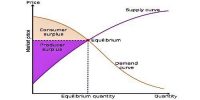The only value a company builds is consumer value. The consumer is the heart of any business. Very often, managers conduct a customer value analysis to reveal the company’s strengths and weaknesses relative to those of various competitors. The steps in this analysis are:
(1) Identify the major attributes and benefits customers’ value. Customers are asked what attributes, benefits, and performance levels they look for in choosing a product and vendors. Attributes and benefits should be defined broadly to encompass all the inputs to customers’ decisions. At a low level, customer value can be viewed as the attributes of a product that a customer perceives to receive value from.
(2) Assess the quantitative importance of the different attributes and benefits. Customers are asked to rate the importance of different attributes and benefits. If their ratings diverge too much, the marketer should cluster them into different segments. At a higher level, customer value can be viewed as the emotional payoff and achievement of a goal or desire.
(3) Assess the company’s and competitors’ performances on the different customer values against their rated importance. Customers describe where they see the company’s and competitors’ performances on each attribute and benefit.
(4) Examine how customers in a ‘specific segment rate the company’s performance against a specific major competitor on an individual attribute or benefit basis. If the company’s offer exceeds the competitor’s offer on all important attributes and benefits, the company can charge a higher price (thereby earning higher profits), or it can charge the same price and gain more market share.
(5) Monitor customer values over time. The company must periodically redo its studies of customer values and competitors’ standings as the economy, technology, and features change.
A marketer can deliver value, satisfaction, and loyalty by following ways
- Proper recognition of consumer requirements,
- Proper contact of customer requirements to manufactured goods designer,
- Appropriate filling of orders,
- Providing appropriate instructions, preparation, and support to customers,
- Post-sale support,
- Collect criticism and see for ways of development.
CHOICE PROCESSES AND IMPLICATIONS
Some marketers might argue the process we have described is too rational. Suppose the customer chooses the Komatsu tractor. How can we explain this choice? Here are three possibilities.
(1) The buyer might be under orders to buy at the lowest price. The Caterpillar salesperson’s task is then to convince the buyer’s manager that buying on price alone will result in lower long-term profits and customer value.
(2) The buyer will retire before the company realizes the Komatsu tractor is more expensive to operate. The buyer will look good in the short run; he is maximizing personal benefit. The Caterpillar salesperson’s task is to convince other people in the customer company that Caterpillar delivers greater customer value.
(3) The buyer enjoys a long-term friendship with the Komatsu salesperson. In this case, Caterpillar’s salesperson needs to show the buyer that the Komatsu tractor will draw complaints from the tractor operators when they discover its high fuel colt and need for frequent repairs. The point is clear: Buyers operate under various constraints and occasionally make choices that give more weight to their personal benefit than to the company’s benefit.
















